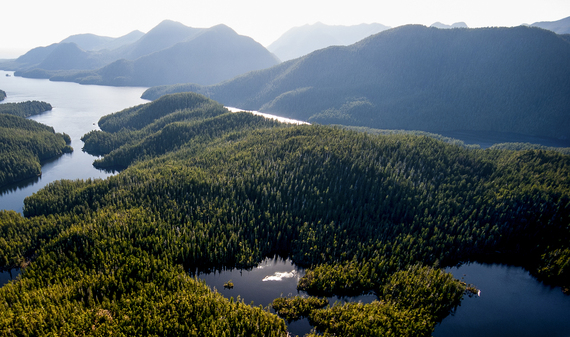
An aerial view of Clayoquot Sound, on the west coast of Vancouver Island in the Canadian province of British Columbia. Photo © Bryan Evans.
Just as the world gets to grips with the urgency of limiting global warming to beneath 2°C, the official UN body charged with climate science (the IPCC) has been charged with understanding potential impacts if temperatures rise 1.5°C above pre-industrial levels and how we might limit emissions to stay beneath this threshold.
For those familiar with the complexities of climate change - and the communication challenges it faces - the 1.5 number is not new in and of itself - scientists have long stressed the need to keep warming levels to 'well below' 2°C. And as 130 countries sign the Paris Agreement - the world's first fully comprehensive climate agreement which lays out a collective goal of keeping global warming to below 2°C, it also contains sentiment to pursue efforts to limit the temperature rise to 1.5C.
Understanding the importance of this difference of 0.5 degrees requires a thesis in its own right, and many commentators are concerned with how we might get there.
Emerging consensus is leading to a growing focus on the need for 'negative emissions' technologies. In other words, how do we take CO2 out of the atmosphere once it's been created? It can refer to myriad controversial and technically difficult technologies, and often mean the large-scale deployment of carbon capture and storage technologies which bury CO2 deep underground.
My work at The Nature Conservancy is international, but I am based in Oxford, where we are building relationships with Oxford University to explore this topic. Later this year, Oxford University is hosting an international conference where scientists, policymakers, businesses and civil society will come together to better understand what it would take to get to 1.5 degrees. My hope is that by then, we will have been successful in beginning to change the narrative - backed up by our own emerging research - about the scale of the role that nature (a sometimes forgotten solution) can play to stabilize our climate.
The time for natural solutions is now.
Land use is already high up on the IPCC agenda: an extra special report will cover 'desertification, land degradation, sustainable land management, food security, and greenhouse gas fluxes in terrestrial ecosystems'. This is an extremely complicated set of issues - that cuts across cutting emissions and adapting to a changing world - but at its core is a very simple idea: nature has a central role.
This is a topic I have written about a lot in recent months, but in short, it is that natural climate solutions are available to us today - on a massive, global scale - at the time we need them most and when time is not on our side. How do we know this? Latest research shows us that nature can provide around a third of what we need to achieve to slow or stop climate change in the next two decades, if we help in ways such as avoiding deforestation, improving land management techniques and restoring already-degraded lands.
The transition of the world's energy system from fossil-dominated to lower-carbon sources is under way, and signs are encouraging. But it is not happening quickly enough to avert catastrophic climate change. It is this simple fact - that the land use sector is the only sector that can switch from being a net source of carbon to a net sink within as a little as a decade. It's worth reading that sentence again.
All the science indicates that for us to limit warming to 1.5 degrees, we must enhance the role played by nature - which is in fact, the original climate solution. We must save nature to save ourselves. Or save nature so it can save itself and enable it to do what it does best. Keep the planet alive.
Explore The Nature Conservancy's latest thinking, science and recommendations on land conservation.